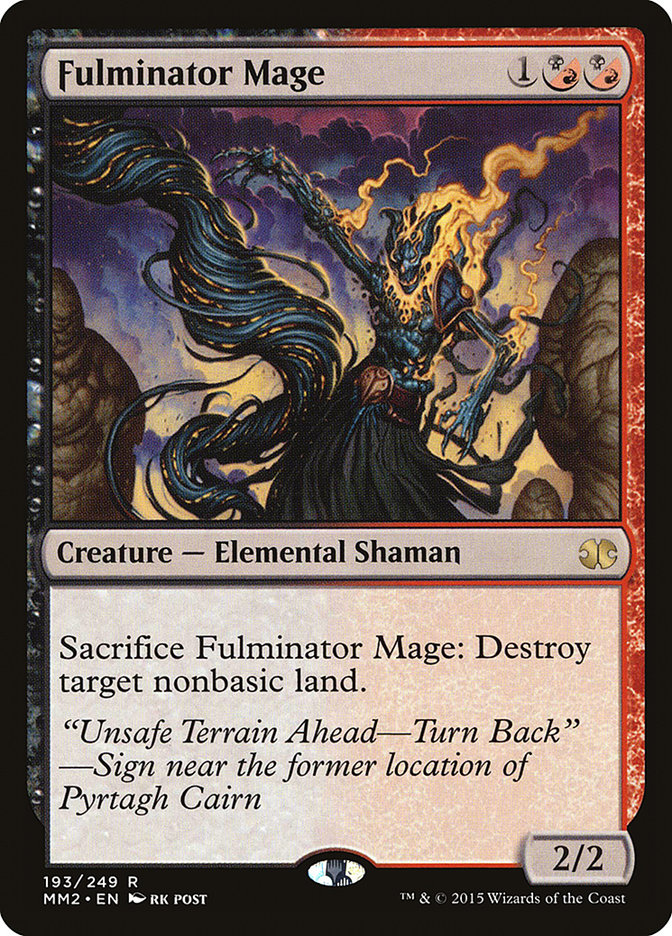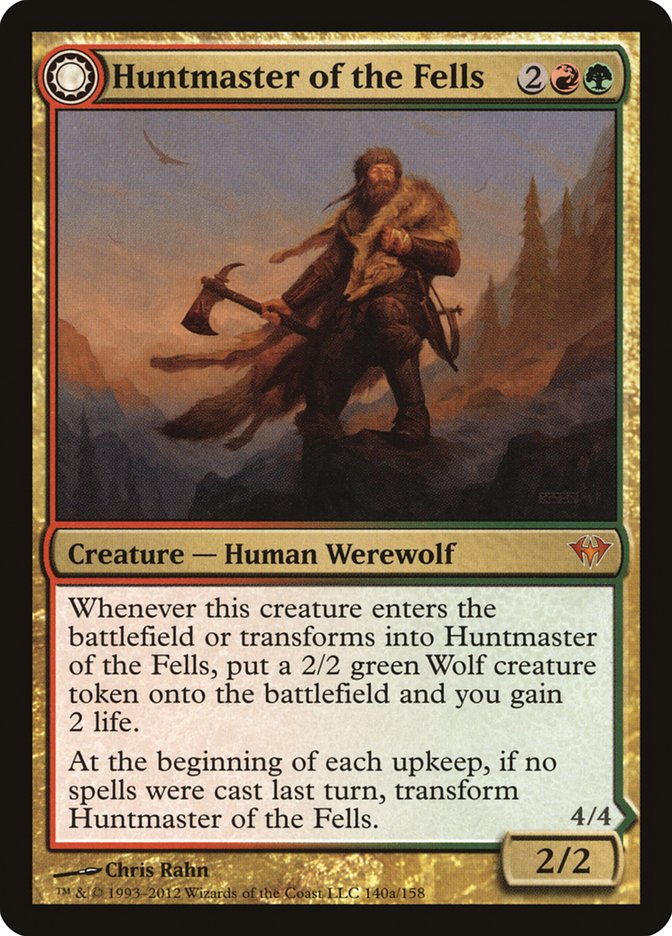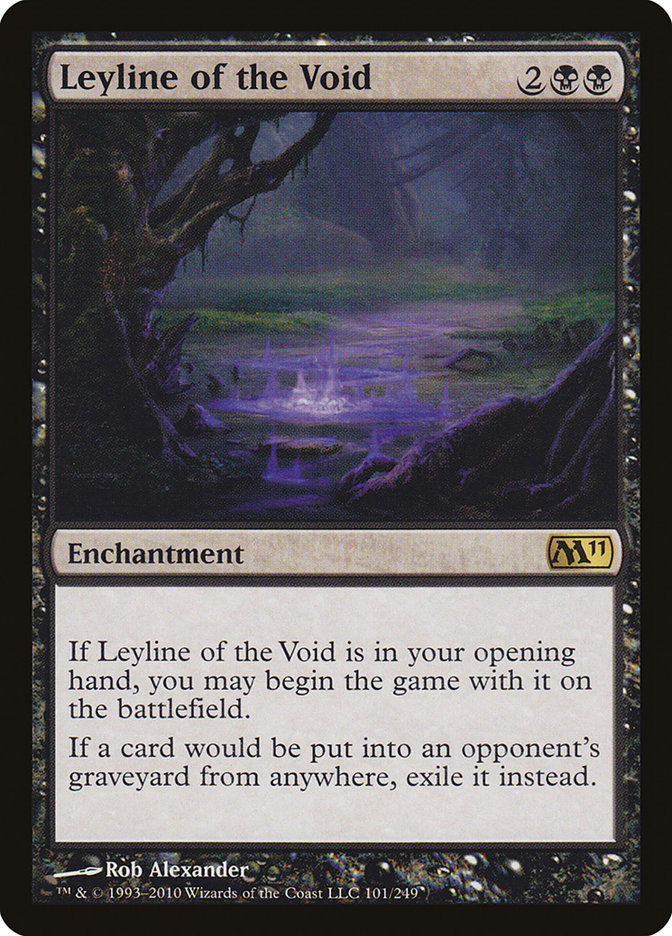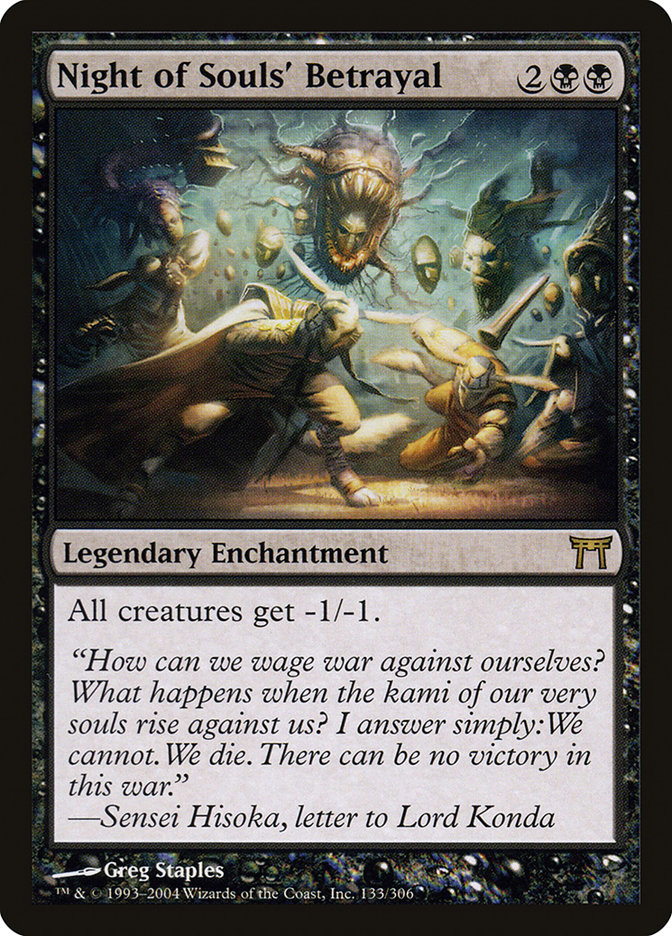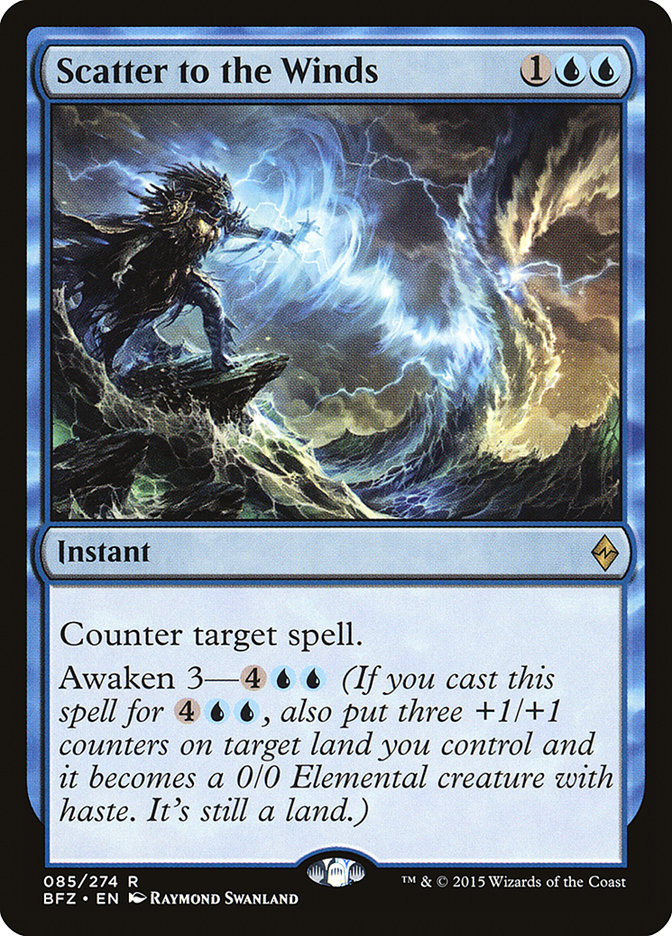This past weekend was a rollercoaster. After taking my third loss in the Modern Open during the first round of play on the second day, I figured my tiebreakers wouldn’t be good enough to make the Top 8, even if I won the last five matches in a row. In a way I was relieved, because the pressure was mostly gone. I needed to win some number of matches to accumulate points in my chase for the Player’s Championship.
But, as standings went up in the last round, I saw that I was behind but not out. All I needed was a small tiebreaker shift to go my way (and win my match, of course) and I could make it into the Top 8. I was pretty sure I was going to get ninth, yet again failing to accumulate enough points to put myself ahead of the rest of the pack in both the seasonal and yearly points races. Fast forward to me defeating my Round 15 opponent and listening as the head judge rattled off the Top 8 competitors. I was actually nervous. I didn’t know what to think.
And then, “In 8th place, Todd Anderson.”
It was my 30th Open Top 8 on the SCG Tour. But unfortunately, the run ended there. Tom Ross handily defeated me with G/W Tron and went on to win the whole tournament. That marks his third Open win this year, a truly impressive feat. He also put himself in a great position to win Player of the Year, earning him three byes at every Open next year. There are only two tournaments left, and I still have a lot of work to do if I want to make the Player’s Championship, but this is the environment where I thrive. I love the pressure. I love the pins and needles right under my skin. And I love the competition.
I’m just not sure they love me.
Creatures (13)
Planeswalkers (4)
Lands (24)
Spells (19)

There’s a lot to talk about with the Jund list I decided to play at the Modern Open in Columbus last weekend. For starters, many of you don’t actually know me as a Jund player. And if I’m being honest with myself, I don’t think I’m much of a Jund player either. I tried to step out of my comfort zone, and I’d gotten a little practice in smaller tournaments over the last few months, and finally decided to take the leap. After losing two of my first few rounds to Jeskai Control, I wasn’t feeling good about my chances. Luckily, I was able to rattle off some key wins in tough spots, even defeating a G/R Tron opponent along the way.
One thing I’m sure people will ask me: why aren’t you playing hate for land-based strategies? For one, I don’t think it is necessary. Cards like Fulminator Mage force you to sacrifice a turn of progressing the battlefield to slow your opponent down. But what you probably don’t realize is that their entire deck is designed to build back that mana. The turn you cast Fulminator Mage will rarely win you the game, and only buy you one turn in most scenarios.
My strategy, that I’ve come to love in Modern tournaments, is ignore a specific type of deck and just hope you don’t play against it. Focus on the things you can control. Even if you did have Fulminator Mage in your deck, how much do you think it would help your chances of winning that particular matchup? I’d rather have cards that fight strategies that I’m more likely to face, such as Dredge, instead of playing scared. While cards like Fulminator Mage have applications in other matchups like Jeskai, Scapeshift, or other land-based decks, they just don’t have a very high impact. Now, if we built our deck like the Jund decks from last year, featuring a ton of Kolaghan’s Command and possibly maindeck Fulminator Mage, we might have a good chance of defeating these strategies. But that version of the deck is less likely to beat the current Modern landscape.
The Bad
Scavenging Ooze has been a card I’ve really disliked in the strategy for some time.
However, it is difficult to argue with how good it can be in any Jund mirror. It often grows larger than Tarmogoyf and can dominate the battlefield all by itself, all while padding your life total. It shines against Burn and Zoo decks and acts as a cheap threat to back up your discard effects against opponents trying to do unfair things.
It is also one of your best cards against Dredge, though you rarely have the time to make it work. And that’s the main problem with Scavenging Ooze, in my opinion. It is just too slow to interact with the deck it should be phenomenal against.
Huntmaster of the Fells was another card I waffled on, but it seemed to be gaining some steam in online versions of the deck. I wasn’t happy about it because I just wanted to play Grim Flayer, but I was ultimately convinced the format could sway more toward midrange and control, making Huntmaster of the Fells a better choice.
It can help you win long games and gain you precious life points against Burn or Zoo, but it just wasn’t enough.
If I had to play the tournament over again, I would prefer something like Kalitas, Traitor of Ghet. Either that, or lowering the curve once again to play Grim Flayer. Either option is likely better than Huntmaster of the Fells.
Unfortunately, I didn’t get to play against Dredge with my sideboard plan of Leyline of the Void. Instead, my Anger of the Gods got to do some work against a slew of Kitchen Finks strategies. I still think I would play Leyline of the Void, and might even go up to four, but that’s mostly because I hate playing against graveyard decks with a passion. Leyline of the Void is likely better than Nihil Spellbomb and Grafdigger’s Cage, if only because it doesn’t get hit by Abrupt Decay (which Dredge will almost assuredly be bringing in).
The Good
As I was building my deck on Friday night and taking input from Jund Guy Bard Narson, everything he said started to make sense. Even though I wouldn’t play Huntmaster of the Fells again, there were some spots where it legitimately dominated the game. And, in theory, it should have been much better than it was in the games I played. If the other Jund players are packing multiple copies of Chandra, Torch of Defiance in the maindeck, then you need a card that can create two bodies and threaten to take her out on the next turn.
But the rest of the deck performed well. While Scavenging Ooze didn’t dominate anyone like it sometimes can, it did buy me time in just the right spots and it gave me a huge threat to push the leverage gained by having so many removal spells in my deck.
As anyone who has played Jund probably knows, there are roughly 45 cards that don’t really ever change. Dark Confidant, Lightning Bolt, discard spells, Terminate, and a few others are mainstays, and those cards are always generically good, regardless of what side of the metagame you come into contact with.
I think Liliana, the Last Hope put us in a tough spot on whether to play four copies of Liliana of the Veil, but I’ve since come to realize that playing less than four is just wrong. Liliana of the Veil is one of the best cards in the deck and often leads to many free wins. Perhaps Grim Flayer versions want to mix it up from time to time, since you are more graveyard-oriented, but I can’t think of many better sequences than Grim Flayer into Liliana of the Veil.
The Awkward
While I would normally call Dark Confidant the best card in the deck behind Lightning Bolt, it just felt off this weekend. That can almost certainly be attributed to the fact that I upped the curve overall, adding Huntmaster of the Fells, but mostly it just died more than it usually does. Perhaps that is a product of me failing to cast discard spells on the first turn in a vast majority of my games, but I also played a handful of matchups where it just wasn’t a very good card to cast. In fact, it was often a liability and had me sweating the flips every turn.
The sideboard felt weird at times, as I found myself with Night of Souls’ Betrayal on the battlefield with Dark Confidant stuck in my hand on multiple occasions, but that didn’t stop me from winning the game. Anger of the Gods with Huntmaster of the Fells and Kitchen Finks was also a common occurrence. All I had to do was make sure I sequenced correctly, but it did put me in spots where my line of play was very difficult to figure out. Regardless, Night of Souls’ Betrayal and Anger of the Gods both won me matches, so if I were to change anything, it would be changing the creatures rather than the removal spells.
The Big Two in Standard
Moving forward to this weekend, we have a Standard Open in Knoxville. Standard is in a strange place, and I honestly have no idea what to do. My gut says to just play one of the two “best decks” in the format. And when I say “best decks,” I don’t mean they’re the only valid options; I mean they’ve been putting up the best results. If you aren’t playing one of these two decks, you need to have a very good reason why.
Spells (11)

W/U Flash seems like a strategy that is right up my alley, but honestly I just hate it. Your creatures aren’t very good at attacking. You aren’t a great Smuggler’s Copter deck. Your counterspells are often awkward or unreliable. Your lands enter the battlefield tapped on the wrong turn a lot of the time.
I could go on. Suffice it to say that I have no idea how this deck keeps winning. Every time I try to play it in a VS video, I get obliterated. Maybe I’m doing it all wrong, or maybe I’m just playing against tough matchups. Regardless, this deck keeps winning a lot, so you should pay attention to it. At the very least, know all the possible things your opponent can do with whatever open mana they have. I’m sure most W/U Flash players get a free win or two just because their opponent walks into their Spell Queller or Archangel Avacyn.
Creatures (16)
- 2 Pilgrim's Eye
- 1 Kalitas, Traitor of Ghet
- 2 Mindwrack Demon
- 2 Tireless Tracker
- 1 Emrakul, the Promised End
- 3 Ishkanah, Grafwidow
- 4 Grim Flayer
- 1 Noxious Gearhulk
Planeswalkers (4)
Lands (23)
Spells (17)

Ah, yes, the deck that can’t win a game without casting Ishkanah, Grafwidow. Unfortunately for us, they have a lot of ways to find it and get it back if you’re able to deal with it. Plus, you have to beat them before they start casting Emrakul, the Promised End. So there’s that.
By all accounts, B/G Delirium should be the best deck in the format. It has draws that can be off-center from time to time since it is so reliant on early enablers to find mana sources. However, you’d be a fool to think they aren’t going to execute nearly identical plans every game. Their primary goals shift based on whatever the given matchup is, but they have all the right tools at their disposal.
If I had to pick one of these two decks for the weekend, it would 100% be B/G Delirium. It seems like it has a better gameplan against the rest of the field and it is less easy to pick apart. That’s the main draw of midrange strategies in the first place.
Going Over the Top
Creatures (11)
Planeswalkers (3)
Lands (22)
Spells (24)

After getting trounced by this deck today while playing W/U Flash, I don’t know why this archetype isn’t seeing more play. Aetherworks Marvel is a powerful engine that can overwhelm any midrange deck and seems like it would be an underdog to W/U Flash. Any deck that hinges on a single card is likely to fail against Spell Queller and company.
But this isn’t any normal Aetherworks Marvel deck.
In reality, this version of Aetherworks Marvel plays much like a normal G/R Ramp strategy with the capability of easily turning on Aetherworks Marvel. Servant of the Conduit and Harnessed Lightning are regular cards that just so happen to make energy. Aether Hub and Attune with Aether make sure you hit both colors easily while also adding energy. In truth, the only true dedicated card to gaining energy is Woodweaver’s Puzzleknot. And in a lot of situations, Woodweaver’s Puzzleknot will gain you enough life to survive until Emrakul, the Promised End or Ishkanah, Grafwidow can be cast.
While this deck isn’t revolutionary, I do think it is doing powerful things. The format seems to have become much slower in the wake of B/G Delirium and W/U Flash taking up the top slots, which means slower decks can come in and make a big splash. If you were to tell me the format was full of aggressive decks, I wouldn’t think this a great choice. But with the format being as lopsided toward those two decks as it is right now, this version of Aetherworks Marvel might be a great choice.
And I’m heavily considering it for this weekend in Knoxville.
Cutting Through
Creatures (9)
Planeswalkers (3)
Lands (25)
Spells (23)

If going over the top and casting big spells isn’t really your jam, might I suggest this interesting take on control? U/R Control, in all forms, usually gets me right in the gut. I love this style of deck, and I don’t actually know why. Of course, I’d change a few things before taking it into battle, but I do understand every card choice in this list.
For starters, I’d play Void Shatter over Scatter to the Winds. I get that this deck can turn a corner in a hurry, and you can actually pressure your opponents with the 3/3 body from Scatter to the Winds, but I’m not in the business of allowing my opponents to get full value from Grapple with the Past. I want what I’m countering to be exiled permanently.
If you take into consideration the fact that this deck is likely an underdog to B/G Delirium, it might not be a great choice. They can just play Magic forever, what with Tireless Tracker and Liliana, the Last Hope gaining incremental card advantage. Plus, with so many virtual copies of those cards thanks to Grapple with the Past and Traverse the Ulvenwald, it will be difficult to actually close out the game.
And Ishkanah, Grafwidow is still a huge nuisance if it resolves.
But such is the plight of the control player. Midrange decks have been ruling Standard for months now, and just when we thought midrange would get a little worse with the rotation of Collected Company, we get B/G Delirium gumming up the works. Yes, two control decks made it to the finals of Pro Tour Kaladesh, but what have they done since then? It is not an anomaly for the Pro Tour-winning deck to fall out of favor once people get a handle on the format. I’m just not sure exactly what transpired for that to be the case.
I’ve beaten my fair share of B/G Delirium and W/U Flash with all sorts of control decks, but I never felt like I was ahead. I always needed a good topdeck in one or two spots to steal games, and that isn’t always going to happen. What we really need, at this juncture, is for control to evolve. I’ve seen a bit of that in this list with Whirler Virtuoso, but I want to see more. Perhaps the answer is going hard with Dynavolt Tower again. After all, my losses with that deck were almost always to Bristling Hydra. With G/R Energy all but extinct in the format, it might be time to dust it off again.
Off to the Races
Going into this weekend, I am in heavy competition for a qualification to the Players’ Championship. Whether or not I make it in, I’m expecting a lot of pushback from all the other players on the leaderboard who are also in contention. I saw it last year with Caleb Scherer. I’m sure we’ll see it this year with Todd Stevens and a few others.
For me, getting back to the Players’ Championship is about one thing: doing just a little bit better than I did last year. Losing in the finals to Jim Davis was one of toughest losses of my career, and I’ve been doing everything I can to get back to that stage and prove that I can be the Players’ Champion. I hope you tune in to the broadcast this weekend for the last Open of the year leading up to the Invitational, and I hope you’re cheering for me.
‘Cause I’m about to put on a show.


